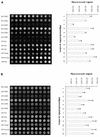Investigation of the multiple anchors approach in oligonucleotide microarray preparation using linear and stem-loop structured probes
- PMID: 11937642
- PMCID: PMC113229
- DOI: 10.1093/nar/30.8.e34
Investigation of the multiple anchors approach in oligonucleotide microarray preparation using linear and stem-loop structured probes
Abstract
Enzyme-mediated reactions are a useful tool in mutation detection when using a microarray format. Discriminating probes attached to the surface of a DNA chip have to be accessible to target DNA and to the enzyme (ligase or polymerase) that catalyses the formation of a new phosphodiester bond. This requires an appropriate chemical platform. Recently, an oligonucleotide hairpin architecture incorporating multiple phosphorothioate moieties along the loop has been proposed as an effective approach to solid-phase minisequencing. We have explored in depth several variables (stem length, number of phosphorothioates, stem-loop architecture versus linear structure) involved in this strategy by using a solid-phase ligation reaction. Microarrays were fabricated either from aminosilyl-modified glass or from aminated polymeric surfaces made of poly-lysine. Both platforms were bromoacetylated and reacted with thiophosphorylated oligonucleotides. The resulting microarrays were tested using either a synthetic template or a PCR-amplified 16S rRNA genomic region as the target sequence. Our results confirm the robustness of the proposed chemistry. We extend its range of application to solid-phase ligation, demonstrating the effectiveness of multiple anchors and suggest that linear oligonucleotides incorporating multiple phosphorothioates are equivalent to their hairpin-structured counterparts.
Figures





References
-
- Gerry N.P., Witowski,N.E., Day,J., Hammer,R.P., Barany,G. and Barany,F. (1999) Universal DNA microarray method for multiplex detection of low abundance point mutations. J. Mol. Biol., 292, 251–262. - PubMed
-
- Joos B., Kuster,H. and Cone,R. (1997) Covalent attachment of hybridizable oligonucleotides to glass support. Anal. Biochem., 247, 96–101. - PubMed
-
- Rogers Y.H., Jiang-Baucom,P., Huang,Z.J., Bogdanov,V., Anderson,S. and Boyce-Jacino,M.T. (1999) Immobilization of oligonucleotides onto a glass support via disulfide bonds: A method for preparation of DNA microarrays. Anal. Biochem., 266, 23–30. - PubMed
-
- Proudnikov D., Timofeev,E. and Mirzabekov,A. (1998) Immobilization of DNA in polyacrylamide gel for the manufacture of DNA and DNA-oligonucleotide microchips. Anal. Biochem., 259, 34–41. - PubMed
Publication types
MeSH terms
Substances
LinkOut - more resources
Full Text Sources
Other Literature Sources

